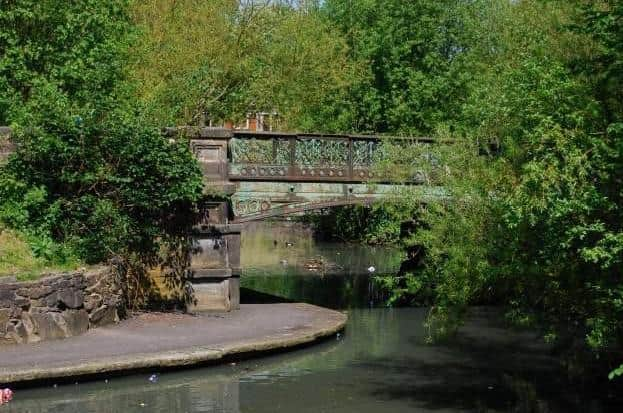Yorkshire Water up in court over sewage pollution incident on Bradford Beck
Yorkshire Water appeared at Leeds Magistrates Court today charged with two counts of knowingly causing or permitting a person to operate a regulated facility without authorisation of environmental permit in 2018 and 2017, and four counts of failing to comply with or contravene environmental permit conditions in 2017.
The case has been adjourned until July.
The allegations date back to 2018, when Bradford Beck, a major tributary of the River Aire, was affected by a prolonged sewage discharge in Bradford city centre.


Advertisement
Hide AdAdvertisement
Hide AdA group of citizen scientists who monitor the waterway then submitted evidence to the Environment Agency, who launched a full investigation - including findings of the impact the discharge had on wildlife in the river, such as fish and invertebrates.
Yorkshire Water declined to comment until the case has concluded.
Bradford Beck - a history of a river 'abused and misused' during the city's industrial heyday
Most of the old Beck watercourse has now been culverted and runs underground beneath the buildings of the city centre - including City Hall.
Advertisement
Hide AdAdvertisement
Hide AdYet it once had a prominent, if somewhat detrimental, role in the public life of the growing Victorian city.
The pollution in the Beck during Bradford's industrial heyday was so noxious that gas could be seen rising from the surface and it was a major talking point among civic leaders determined to clean up the river.
The Beck is the Ice Age river that drains the dale that Bradford was built on. There are several tributaries that feed into the Beck, and the name was traditionally used once the river entered the city at Crossley Hall. It eventually joins the River Aire just downstream of Baildon Weir.
As Bradford first began to industrialise, the unculverted small rivers were important as a power source for mills, and the first weirs were built to alter the water flow.
Advertisement
Hide AdAdvertisement
Hide AdThere is little doubt that Bradford Beck was once one of the dirtiest rivers in Britain. In 1867, two million gallons of sewage water were being pumped into the Beck every day.
The nickname 'Mucky Beck' is still used today - by 1826, when industrialisation was in full swing, it was described as a 'sink of filth'. There were no public sewers, and the Beck had been diverted to run into a stagnant canal basin where effluent gathered and festered.
In hot summers, bubbles of gas caused by decaying animal offal would rise to the surface, and the stench was terrible.
In the 1860s, when London's River Thames was becoming notoriously polluted, government officials were also highlighting the state of Bradford's waterways.
Advertisement
Hide AdAdvertisement
Hide AdThey reported that children often managed to set the canal on fire for amusement, so easy was it to ignite the gases emitted.
In 1899 it was decried as 'the most filthy stream in the West Riding'.
Much of the pollution was caused by industrial waste. The processing of animal hides and wool creates excess products such as faeces and lanolin, which were often dumped in the river. The animal fats suck oxygen from the water, meaning that no wildlife can live there. In 1899, 18 factories and mills in Bradford were found to be discharging waste straight into one of the becks.
Domestic waste also contributed to the issues - before 1862, there were no sewers in Bradford, although much of the waste collected from privies was recycled as fertiliser or for industrial use.
Advertisement
Hide AdAdvertisement
Hide AdBy 1870, when the installation of sewers had begun, the 30 miles of pipes discharged directly into the Beck at Frizinghall. Even attempts to treat the sewage proved problematic, as it was difficult to process the industrial by-products. Liquid effluent was not treated, and still made its way into the Aire.
Major treatment works at Esholt were finally completed in 1912, and sewage was re-routed from Frizinghall via an underground pipeline.
Hardly any of the streams and becks can be seen today. They've either been culverted and built over, or 'canalised' between high walls with little public access.
Many Bradford landowners built over the rivers in pursuit of profit, and enclosure was also seen as a convenient way of preventing smells from being released at street level.
Advertisement
Hide AdAdvertisement
Hide AdThe major 19th-century culverting drive has resulted in a maintenance programme that is still ongoing today, at the expense of Bradford Council.
A culvert beneath the Broadway shopping centre was rebuilt in the 1950s in brick and again in concrete 20 years later. The stage of the Odeon cinema was built over the culvert, leading to stories of rats emerging during showings. The Beck had to be re-culverted in 1986 when the Grattan warehouse was built, and in 2015 the Canal Road widening scheme required another 50 metres of water to be covered.
The Beck has entered urban legend - stories abound of foul smells emerging that are caused by rotting animal carcasses dumped in the river during Victorian times.
Barney Lerner from the Friends of Bradford Beck group is quick to quash the myth.
Advertisement
Hide AdAdvertisement
Hide Ad"You can frequently smell the Beck under the city - often the smell is bad at Foster Park shopping centre. But it's nothing to do with things being dumped in it 200 years ago, it's all been rebuilt several times since then."
